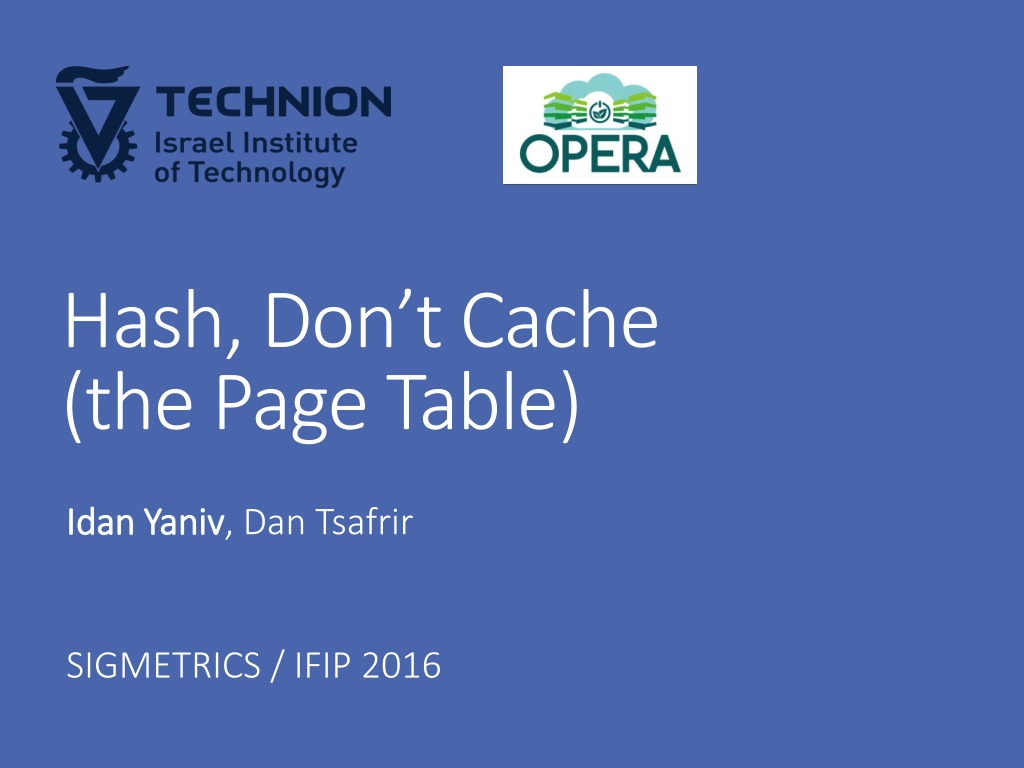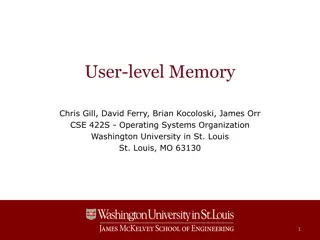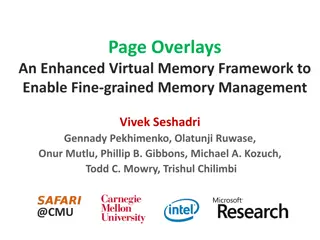Insights into Virtual Memory Management Challenges
Exploring various aspects of virtual memory management, such as TLB misses, page table optimizations, and the role of hashed page tables, shedding light on the evolution and complexities of memory addressing in computing systems.
Download Presentation

Please find below an Image/Link to download the presentation.
The content on the website is provided AS IS for your information and personal use only. It may not be sold, licensed, or shared on other websites without obtaining consent from the author. Download presentation by click this link. If you encounter any issues during the download, it is possible that the publisher has removed the file from their server.
E N D
Presentation Transcript
Hash, Dont Cache (the Page Table) Idan Yaniv Idan Yaniv, Dan Tsafrir SIGMETRICS / IFIP 2016 1
Virtual memory was invented in a time of scarcity. Is it still a good idea? Charles Thacker, ACM Turing Award Lecture, 2009 2
Radix page tables virtual address hit? physical address TLB miss? index 4 index 3 index 2 index 1 offset PTE PTE PTE data page PTE CR3 3
TLB misses are the bottleneck TLB size [entries] L1 cache L2 cache Ivy Bridge (2013) Haswell (2013) Broadwell (2015) 512 64 KB 256 KB 1024 64 KB 256 KB 1536 64 KB 256 KB 4
Virtualization requires 24 steps Context 5
PWCs in best-case scenario Context Problem statement 7
So radix cause long page walks, and PWCs try to cut them down 8
Hashed page tables do that! memory refs. per walk optimal radix radix hashed 4 1 1 bare-metal 24 3 3 virtualized 9
Then why not hashed? legacy, of course. some claim that hashed perform poorly. 10
[hashed page table] increases the number of DRAM accesses per walk by over 400% Skip, Don t Walk (the Page Table) , ISCA 2010 11
We found out that this statement is onlytrue for the Intel Itanium design ! 13
In this talk we will revisit the Itanium hashed page table. present 3 improvements. debunk ISCA 10 finding, and show that hashed can perform better than radix+PWCs. 14
Itanium hashed page table virtual page number offset hash hash table tag tag PTE PTE tag PTE CR3 15
Itanium hashed page table virtual page number offset hash hash table chain table tag tag PTE PTE tag PTE tag PTE tag PTE CR3 16
Itanium hashed page table only 1 memory access per walk ! assuming no collisions but in practice it suffers from: chain pointers waste space poor locality tags waste space 17
Weakness #1: chain pointers waste space radix entry radix entry hashed entry hashed entry 8 8 bytes 32 32 bytes PTE tag PTE pointer 18
Weakness #1: chain pointers waste space radix entry radix entry hashed entry hashed entry 8 8 bytes 32 32 16 16 bytes PTE tag PTE pointer twice more entries! 19
Solution #1: open addressing virtual page number offset hash hash table chain table tag tag PTE PTE tag PTE tag PTE tag PTE CR3 20
Solution #1: open addressing virtual page number offset tag PTE hash tag PTE tag tag PTE PTE collision? CR3 21
Solution #1: open addressing ( decrease the load factor) occupied slots load factor = total slots load factor 1.5 1.15 1.07 page walk length 22
Weakness #2: poor locality in radix, consecutive in hashed, mappings mappings are adjacent: are scattered: 23
Solution #2: clustering block number block offset offset hash 64-byte cache line tag PTE0 PTE1 PTE2 PTE3 tag PTE0 PTE1 PTE2 PTE3 CR3 24
Weakness #3: tag field wastes space hashed pack 4 PTEs: tag PTE0 PTE1 PTE2 PTE3 64 64- -byte cache line byte cache line radix pack 8 PTEs: PTE0 PTE1 PTE2 PTE7 25
Solution #3: compaction tag PTE0 PTE0 PTE1 PTE1 PTE2 PTE2 PTE3 PTE3 tag tag PTE0 PTE1 PTE2 PTE7 26
Solution #3: compaction ( decrease the load factor) occupied slots load factor = total slots load factor 1.5 1.15 1.07 page walk length 27
Summary: how we improved the Itanium? 28
Itanium baseline virtual page number offset hash hash table chain table tag tag PTE PTE tag PTE tag PTE tag PTE CR3 29
Itanium baseline open addressing virtual page number offset tag PTE hash tag PTE tag tag PTE PTE collision? CR3 30
Itanium baseline open addressing + clustering block number block offset offset hash tag PTE0 PTE1 PTE2 PTE3 tag PTE0 PTE1 PTE2 PTE3 CR3 31
Itanium baseline open addressing + clustering + compaction block number block offset offset hash tag PTE0 PTE1 PTE2 PTE3 PTE4 PTE5 PTE6 PTE7 64-byte cache line CR3 32
hashed radix 33
Hashed perform better than existing x86-64 hardware reducing benchmark runtimes by 1% 27% in bare-metal setups, 6% 32% in virtualized setups, without resorting to page walk caches. * for comparison: Haswell is up to 6% faster than Ivy Bridge. 34
Hashed approximate optimal radix (i.e., infinite PWCs which never miss) average runtime improvement hashed optimal radix 8 % 6 % bare-metal 17 % 16 % virtualized 35
SPEC CPU2006 31 benchmarks. memory footprint < 2GB. most of the benchmarks exhibit very few TLB & PWC misses; for them hashed and radix perform equally well. 3 benchmarks are sensitive to PWC misses. 36
SPEC CPU2006 37
Radix page tables do not scale as the memory footprint grows. as the locality of reference drops. as more virtualization layers are added. 38
Nested virtualization for ? levels of virtualization, with page walk length of ? at each level, the overall page walk length is overall page walk length is ? + ?? ? hashed (? = 1) radix (? = 4) bare-metal 1 4 virtualized 3 24 nested virt. 7 124 40
Methodology or: how to evaluate HW that doesn t exist? 41
Methodology state-of-the-art in virtual memory research. used by: Basu, Gandhi, Chang, Hill et. al., ISCA ISCA 2013. 2013. Bhattacharjee, MICRO MICRO 2013. 2013. Gandhi, Basu, Hill et. al., MICRO MICRO 2014. 2014. 42
Methodology Phase 1 (off-line): Phase 2 (on-line): build a model. simulate and apply. runtime runtime walk cycles walk cycles simulation simulation 43
Conclusions 44
Radix vs. Hashed radix radix hashed hashed big memory low locality nested virtualization 45
Thanks for listening! Questions? 46
Cons of hashed multiple page sizes. dynamic resizing. Possible solution: segmentation. another level of translation at larger granularity. e.g. 256 MB segments. 48
Graph500 multi-threaded graph construction & BFS. input sizes: 4 , 8 , 16 GB. 50























